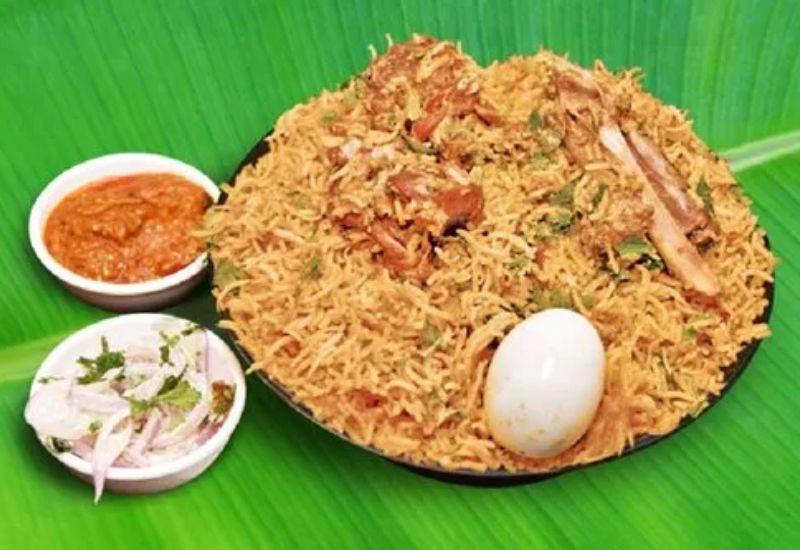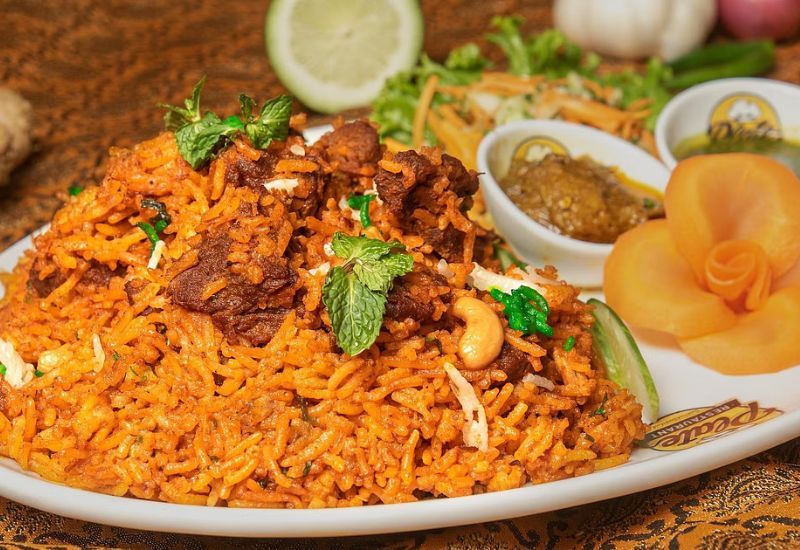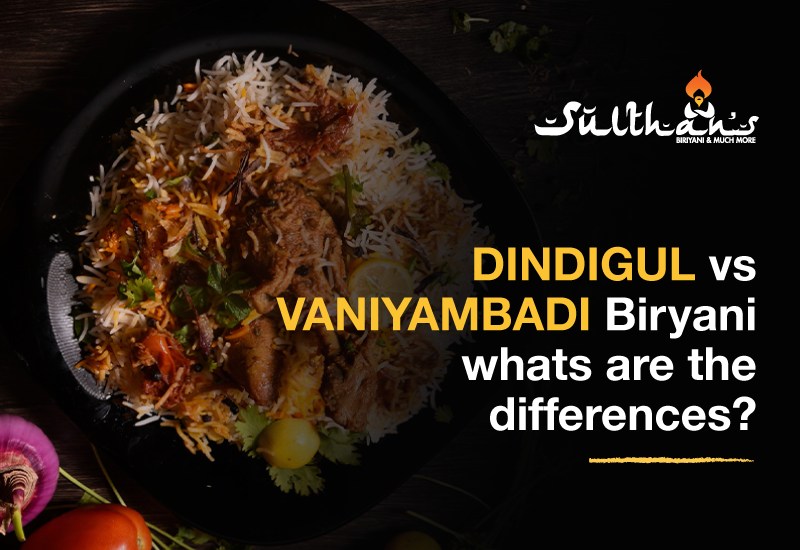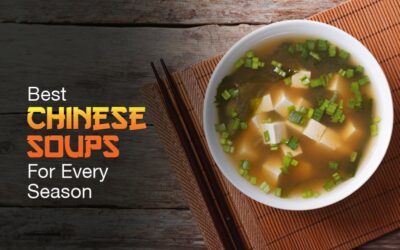Introduction
Biryani lovers in Tamil Nadu are quite familiar with the two popular biryanis originating from different parts of the state- the aromatic Dindigul Biryani and the tangy Vaniyambadi Biryani. While both pack distinctive flavours and textures, some key differences set them apart.
This blog will deeply explore the origins, ingredients, taste profiles and best places to try these delicious biryanis.
Also check
Lucknowi Biryani or Hyderabadi Biryani?-The Real Biryani Battle
Here is what you need to know about the biryani battle: Dindigul Vs Vaniyambadi Biryani!

A biryani battle well worth exploring for any rice lover! Let’s get started!
Origins
Dindigul Biryani hails from the town of Dindigul in the Madurai region of Tamil Nadu. It was developed and popularised by the famous Dindigul Thalappakatti restaurant in the 1950s, which now has over 70 outlets across India and overseas.
On the other hand, Vaniyambadi biryani originated in the towns of Ambur and Vaniyambadi in the Vellore district. It is believed to have been introduced in the area during the rule of the Nawabs of Arcot in the 1800s.
Rice Varieties
One of the significant differences between the two biryanis is the type of rice used. Dindigul Biryani uses a unique, short-grained aromatic rice variety called seeraga samba, while Vaniyambadi Biryani uses the classic biryani rice- basmati.
The seeraga samba rice adds a distinct texture and flavour that sets Dindigul biryani apart from other varieties. With its long grains and fragrant flavour, Basmati rice perfectly absorbs the spices in Vaniyambadi biryani.
Spices and Flavours
Dindigul biryani packs quite a spicy punch because of the liberal use of chillies and spices like star anise, cinnamon, cardamom, fennel seeds, cloves and pepper. Red and green chillies are added to provide spice and vibrant colour.
Vaniyambadi biryani has a milder flavour profile where the aromatic spices take centerstage rather than chilli heat. Saffron, cardamom and spices like cinnamon and bay leaves lend it a royal, nuanced flavour.
Meat Used
Mutton is the choice of meat for Dindigul biryani, while Vaniyambadi style uses both mutton and chicken. Bone-in cuts like ribs or leg meat are preferred as they impart more flavour and juices while cooking. The meat is seasoned generously before being layered with the aromatic rice for a unique flavour.
Cooking Method
The dum pukht (slow breathing) cooking style by sealing the lid tightly is used for both varieties to allow the meat, spices and rice to blend beautifully. The meat is usually cooked till three-fourths done before it is layered in the biryani pot alternately with rice. This slow-cooking method allows all the juices and flavours to permeate through the rice.
Global Appeal
Both Dindigul and Vaniyambadi biryanis have now gained global appeal. Thalappakatti and a few other chains have successfully taken Dindigul biryani overseas with outlets in the US, UK, Singapore and the Middle East. Tourists and visitors flock to Vaniyambadi and Ambur to get a taste of the signature biryani in the towns it originated from.
Here are the most anticipated recipes!

Traditional cooking methods have also changed in recent times according to feasibility. Here are the recipes of the Dindigul and Vaniyambadi Biryani that are famous now.
Dindigul Biryani
Ingredients needed:
For the Masala:
- 5 green chillies
- 2 pieces two-inch cinnamon sticks
- 3 cardamom
- 3 cloves
- 1⁄8 Nutmeg
- 1 piece mace
- 2 inch ginger
- 12 cloves garlic
- 10 Shallots
For Biryani:
- 500 ml Seeraga Samba Rice
- 500 grams of mutton with bone
- 2 tbsp ghee
- 3 tbsp sunflower oil
- 1⁄2 tsp red chilli powder
- 1⁄2 cup curd
- 11⁄2 tsp salt
- A handful of Mint leaves
- A handful of Coriander leaves
- Juice of half a lime
Method:
- Wash the rice and soak it for 30 minutes.
- Make a masala paste by blending the masala ingredients with 1/2 cup water.
- In a pressure cooker, heat oil and ghee. Sauté the masala paste.
- Add mutton and sauté. Add 2 cups water, salt, chilli powder, curd. Cook for 20 minutes.
- Remove from heat and release pressure. Take out mutton.
- Adjust the stock-water ratio to rice quantity (twice the rice amount).
- Add stock water to the cooker and bring to boil.
- Add mutton, drained rice, coriander, mint, salt, and lime juice.
- Cook for 5 minutes on medium-low. Mix and cook for 10 minutes on low.
- Uncover and cook for a few more minutes. Mix.
- Switch off, cover and let sit 20 minutes before serving hot.
Vaniyambadi Biryani

Ingredients needed:
- 500g chicken, cut into pieces
- 500g basmati rice
- 5 green chillies
- 2 medium onions, sliced
- 1 large tomato, sliced
- 1 medium tomato, sliced
- 1 lime
- 5 sprigs coriander
- 5 sprigs mint
- 1 tbsp ginger paste
- 1.5 tbsp garlic paste
- 1 cinnamon stick
- 3 cardamoms
- 4 cloves
- 2 bay leaves
- 1.5 tbsp yogurt
- 1 tbsp chilli powder
- 0.5 tsp turmeric powder
- Salt
- Oil
Masala Paste:
- 5 almonds
- 0.5 tsp cumin seeds
- 3 cloves
- 3 cardamoms
- 2 inch cinnamon
Method:
- Prepare the ingredients as described above. Make a paste of the masala paste ingredients.
- In a pot, heat oil and add whole spices. Fry until fragrant.
- Add onions and fry until translucent. Add garlic and ginger pastes and fry until golden.
- Add tomatoes, green chillies, spices, yoghurt and fry until tomatoes are half-cooked.
- Add chicken and masala paste. Fry for 2-3 mins until chicken is coated.
- Add mint, coriander and salt. Cover and cook chicken.
- Soak rice for 30 mins. In another pot, bring water to a boil.
- Add rice and water to the chicken. Cook rice until 70% done.
- Cover, reduce heat and cook for 15 mins until rice is tender.
- Fluff rice and mix with chicken. Serve garnished with mint coriander.
Where to Eat?
For the quintessential Dindigul biryani experience, head straight to the Thalappakatti restaurant. Be warned that you may have to wait in long lines! For Vaniyambadi biryani, popular picks are Khaja Restaurant and Rahamaniya Briyani Hotel, located in Vaniyambadi and Ambur towns, respectively.
You can watch the biryani being made traditionally here in earth pots.
Head to Sulthan’s Biryani for your Biryani Cravings!

We understand you cannot go to Dindigul or Vaniyambadi to try out your favourite biryanis all the time! Don’t fret! Sulthan’s biryani is a one-stop solution for your sudden food thirst!
Be it Hyderabadi, Lucknawi, Chettinad, or Kolkata-style biryani, made of chicken, mutton and prawns, you name it, and Sulthan’s Biryani has it! The restaurant prepares your favourite meal using the traditional woodfire method to let you experience authentic and genuine flavours in every bite.
Conclusion
Be it the seeraga samba rice, chilli heat and iconic restaurants that popularised Dindigul biryani or the aromatic, royal flavour with tangy side dishes that define Vaniyambadi biryani- both pack a flavour punch and make for a satisfying biryani experience. The spices, cooking methods and origins may vary, but they exemplify the diversity of biryani cuisine in Tamil Nadu.
So, next time, if you wonder which is better in Dindigul Vs Vaniyambadi Biryani, satisfy your cravings by trying these iconic recipes to understand the subtleties that set them apart. Just be warned- you may end up with a new favourite!
Frequently Asked Questions (FAQs)
1). What is the difference between Ambur and Vaniyambadi biryani?
Though the marination for meat and masala are similar in Ambur and Vaniyambadi biryani, they differ in the type of rice used. Ambur biryani uses seeraga samba, the short and round grain rice. While Vaniyambadi uses basmati rice, the aromatic and long rice grain.
2). What is special in Vaniyambadi biryani?
Vaniyambadi biryani is known for its subtle yet rich blend of spices, which allows the flavours to shine. It uses premium basmati rice, which beautifully soaks up the saffron, cardamom, cinnamon and other aromatics. The inclusion of both chicken and mutton gives it a unique complexity of protein flavours not found in other biryanis.
3). Which is the tastiest biryani?
There are many delicious types of biryani, but most consider Hyderabadi biryani the tastiest. It has a unique combination of spices, rice, and meat, creating a flavorful dish. The slow cooking process allows spices and flavours to permeate the rice, chicken, or lamb.
4). Which city is known as the biryani capital of India?
Hyderabad is often referred to as the biryani capital of India. It is famous for its unique style of biryani, which uses a special mixture of spices. The biryani originated in Hyderabad and has become synonymous with the culture and cuisine of this city in south-central India.
5). Is Dindigul biryani spicy?
Dindigul biryani is generally considered to be quite spicy. The rice used in Dindigul biryani is flavoured with spices like cloves, cinnamon, cardamom and star anise, which give it a distinct flavour. Along with these spices, chilli peppers are also added generously to make it a hot and spicy biryani variety beloved in the Dindigul region of Tamil Nadu.




